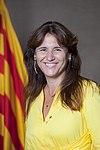Next Pacitalian parliamentary elections: Difference between revisions
(Created page with "{{about|the next parliamentary election in Pacitalia|the most recent national-level election|Pacitalian parliamentary elections, 2023}} {{Infobox election | election_name = Pacitalian parliamentary elections, 2023 | country = Pacitalia | type = parliamentary | vote_type = Party list | ongoing = no | previous_election = Pacitalian parliamentary elections, 2023 | previous_year = 2023 | seats_for_election = All 715 seats in...") |
mNo edit summary |
||
| (3 intermediate revisions by the same user not shown) | |||
| Line 2: | Line 2: | ||
{{Infobox election | {{Infobox election | ||
| election_name = Pacitalian parliamentary elections, | | election_name = Pacitalian parliamentary elections, 2026 | ||
| country = Pacitalia | | country = Pacitalia | ||
| type = parliamentary | | type = parliamentary | ||
| Line 45: | Line 45: | ||
| image5 = [[File:Jordi_Puigneró_retrat_oficial_govern_2021_(cropped).jpg|150x150px]] | | image5 = [[File:Jordi_Puigneró_retrat_oficial_govern_2021_(cropped).jpg|150x150px]] | ||
| leader5 = [[Pere Capderoig]] | | leader5 = [[Pere Capderoig]] | ||
| party5 = Partit dels Socialistes d' | | party5 = Partit dels Socialistes d'Empordà | ||
| color5 = FFFF99 | | color5 = FFFF99 | ||
| last_election5 = 31 seats | | last_election5 = 31 seats | ||
| Line 64: | Line 64: | ||
}} | }} | ||
Parliamentary elections will be held in the [[Pacitalia|Pacitalian Republic]] on or before Monday November 30th, 2026. Officially, this will be the 120th national general election. Voters elect all 715 members of the [[Constazione Repubblicana]], Pacitalia's lower house, and 100 [[Senato Repubblicana|Senators to its upper house]]. | Parliamentary elections will be held in the [[Pacitalia|Pacitalian Republic]] on or before Monday, November 30th, 2026. Officially, this will be the 120th national general election. Voters elect all 715 members of the [[Constazione Repubblicana]], Pacitalia's lower house, and 100 [[Senato Repubblicana|Senators to its upper house]]. | ||
The order of election, which dissolves the parliament, will be issued by the [[Archonate of the Pacitalian Republic|Archonate]] approximately five weeks before the election date, marking the official start of the campaign period. | The order of election, which dissolves the parliament, will be issued by the [[Archonate of the Pacitalian Republic|Archonate]] approximately five weeks before the election date, marking the official start of the campaign period. | ||
| Line 82: | Line 82: | ||
=== Previous election and outcomes === | === Previous election and outcomes === | ||
The previous parliamentary elections were held in [[Pacitalian parliamentary elections, 2023|2023]]. | The previous parliamentary elections were held in [[Pacitalian parliamentary elections, 2023|2023]]. The Pacitalian Social Democratic Congress managed to retain control of the Senato, winning 57 of 100 seats, but lost its majority in the Constazione, earning a large plurality there, with a total of 340. A bare majority is 358 seats. | ||
The Christian Democrats replaced the Federation of Progressive Democrats as the largest opposition party, winning 171 seats. The eDemocrats won 74 seats to become the third-largest parliamentary assembly, while the far-right Defence of the Republic finally broke into the mainstream, electing 34 MRPs. The five major regional parties had their best-ever showing in a national-level election, collectively winning 77 of the 97 available seats in Empordia and Marquería. This was thanks to a cooperation agreement between the ''[[Empordian League|Lliga Empordán]]'' and ''[[Podemos-Derecha Unida]]'' regionally, and their national counterparts, the FPD and Christian Democrats, to try to avoid a split of the centre-right vote. That left the governing PSDC, and Defence of the Republic, as the only major national parties contesting races in Empordia, since the national [[Pacitalian Green Party|Green]] party had previously reached a separate non-compete agreement with [[Verts Empordans|their regional equivalents in Empordia]]. | |||
After the election, Damián Moya was unable to negotiate a coalition arrangement with any other parties. Talks with the [[Partit dels Socialistes d'Empordà|Empordian Socialist Party]] and the eDemocrats broke down well before reaching any formal power-sharing deal. Realizing that progressive parties still held an overall majority, Moya opted to govern alone, despite his party no longer having majority control of both houses. He chose to rely informally on support from other parties in confidence votes. This "plurality government" was the same eventual outcome as in the aftermath of the 2017 election. | |||
== Potential developments == | == Potential developments == | ||
The government is currently exploring whether to change the voting system for the 270 single-member electorate districts in the [[Constazione Repubblicana|Constazione]], from the current {{wp|instant-runoff voting}} method, to either {{wp|First-past-the-post|simple plurality voting}} or {{wp| | The government is currently exploring whether to change the voting system for the 270 single-member electorate districts in the [[Constazione Repubblicana|Constazione]], from the current {{wp|instant-runoff voting}} method, to either {{wp|First-past-the-post|simple plurality voting}} or {{wp|positional voting}}. The other systems are being studied by a parliamentary committee, with a final recommendation due in summer 2025. The changes would not affect Senate elections, which also use instant-runoff voting. | ||
A separate committee is reviewing electorate district boundaries and proposals to increase or decrease the number of overall seats in the Constazione. That committee is also due to present its findings to parliament in 2025. | A separate committee is reviewing electorate district boundaries and proposals to increase or decrease the number of overall seats in the Constazione. That committee is also due to present its findings to parliament in 2025. | ||
Latest revision as of 23:16, 16 November 2024
| |||||||||||||||||||||||||||||||||||||
All 715 seats in the Constazione and 100 seats in the Senato 358 seats needed for a majority in the Constazione 51 seats needed for a majority in the Senato | |||||||||||||||||||||||||||||||||||||
|---|---|---|---|---|---|---|---|---|---|---|---|---|---|---|---|---|---|---|---|---|---|---|---|---|---|---|---|---|---|---|---|---|---|---|---|---|---|
| Registered | TBD | ||||||||||||||||||||||||||||||||||||
| Turnout | TBD Votes can be cast in person or by postal or special ballot | ||||||||||||||||||||||||||||||||||||
| |||||||||||||||||||||||||||||||||||||
| |||||||||||||||||||||||||||||||||||||
Parliamentary elections will be held in the Pacitalian Republic on or before Monday, November 30th, 2026. Officially, this will be the 120th national general election. Voters elect all 715 members of the Constazione Repubblicana, Pacitalia's lower house, and 100 Senators to its upper house.
The order of election, which dissolves the parliament, will be issued by the Archonate approximately five weeks before the election date, marking the official start of the campaign period.
The centre-left Pacitalian Social Democratic Congress, currently led by Damián Moya as of November 2024, will seek a fourth consecutive term in power. The party first took power following the 2017 election. In their first and third terms in office, they formed a government without a formal coalition arrangement, relying on confidence votes from other parties to remain in office. In their second term, the party had overall control of both houses of parliament, after earning a landslide victory in the 2020 election thanks to their handling of the COVID pandemic.
The centre-right Christian Democrats, who have, in recent years, emerged as the largest opposition party and the main conservative party in Pacitalia, will attempt to win their first-ever election. The eDemocrats and the far-right Defence of the Republic hope to build on their best-ever election result in the 2023 election and increase their respective standing in parliament. Meanwhile, the centre-right Federation of Progressive Democrats and centrist Pacitalian Green Party, who are in the process of completing a formal merger to become Progressive Democrats and Greens, will contest their first election as a united party.
Regional parties in Empordia and Marquería will look to build on their strong showings in 2023, at the expense of national parties.
Background
Parliamentary elections in Pacitalia are triennial and held on the last Monday of November, unless circumstances require them to be re-scheduled. Pacitalians also elect their regional governments triennially, though in the year following the parliamentary vote. Archonates, by comparison, are elected to six-year terms.
Pacitalians elect 715 members of the Constazione using the mixed-member form of proportional representation (MMP). There are 445 Members of the Republican Parliament (MRPs) elected through a party list, with the remaining 270 coming from single-member districts whose members are elected using instant-runoff voting (IRV). The weighting of the two blocs of seats typically leads smaller parties to focus their resources on winning party list seats rather than standing candidates in electorates; this leaves the latter bloc to be captured overwhelmingly by larger parties, and has the effect of increasing the odds of the winning party having a workable coalition or an outright majority.
Senators, by contrast, are elected using solely IRV.
Previous election and outcomes
The previous parliamentary elections were held in 2023. The Pacitalian Social Democratic Congress managed to retain control of the Senato, winning 57 of 100 seats, but lost its majority in the Constazione, earning a large plurality there, with a total of 340. A bare majority is 358 seats.
The Christian Democrats replaced the Federation of Progressive Democrats as the largest opposition party, winning 171 seats. The eDemocrats won 74 seats to become the third-largest parliamentary assembly, while the far-right Defence of the Republic finally broke into the mainstream, electing 34 MRPs. The five major regional parties had their best-ever showing in a national-level election, collectively winning 77 of the 97 available seats in Empordia and Marquería. This was thanks to a cooperation agreement between the Lliga Empordán and Podemos-Derecha Unida regionally, and their national counterparts, the FPD and Christian Democrats, to try to avoid a split of the centre-right vote. That left the governing PSDC, and Defence of the Republic, as the only major national parties contesting races in Empordia, since the national Green party had previously reached a separate non-compete agreement with their regional equivalents in Empordia.
After the election, Damián Moya was unable to negotiate a coalition arrangement with any other parties. Talks with the Empordian Socialist Party and the eDemocrats broke down well before reaching any formal power-sharing deal. Realizing that progressive parties still held an overall majority, Moya opted to govern alone, despite his party no longer having majority control of both houses. He chose to rely informally on support from other parties in confidence votes. This "plurality government" was the same eventual outcome as in the aftermath of the 2017 election.
Potential developments
The government is currently exploring whether to change the voting system for the 270 single-member electorate districts in the Constazione, from the current instant-runoff voting method, to either simple plurality voting or positional voting. The other systems are being studied by a parliamentary committee, with a final recommendation due in summer 2025. The changes would not affect Senate elections, which also use instant-runoff voting.
A separate committee is reviewing electorate district boundaries and proposals to increase or decrease the number of overall seats in the Constazione. That committee is also due to present its findings to parliament in 2025.
Elections Pacitalia has also proposed that Pacitalia return to assigning "geographically or historically relevant" names to its electorate districts, rather than numbering them (i.e. "Pungaria-15"). The country's elections authority has suggested either naming districts after historic figures, or, as is done in many other countries, assigning a district name that closely matches its geographic boundaries. The switch to numbered districts occurred back in 2007, and, at the time, was cited as a way to make it more straightforward for voters to determine which district they live in.
Opinion polls
References
Notes
|
|---|
|
|
References
|
|---|
|
|





